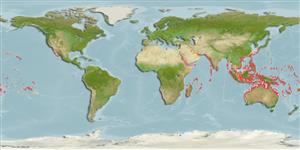分类 / Names
俗名 | 同种异名 | Catalog of Fishes(属, 种) | ITIS | CoL | WoRMS | Cloffa
Teleostei >
Eupercaria/misc (Various families in series Eupercaria)
鱸形目 (Various families in series Eupercaria) >
Labridae (Wrasses)
隆頭魚科 (Wrasses) > Corinae
Etymology: Cheilio: Greek, chanos, -eos, ous, and chasma, -atos = abyss, mouth opened, inmensity + Latin, muraena = morey eel (Ref. 45335).
More on author: Forsskål.
Environment: milieu / climate zone / depth range / distribution range
生态学
海洋 礁区鱼类; 深度上下限 1 - 30 m (Ref. 1602), usually 2 - 30 m (Ref. 27115). 热带; 24°C - 27°C (Ref. 27115); 32°N - 36°S, 24°E - 109°W
Indo-Pacific: Red Sea and East Africa to the Hawaiian and Easter islands, north to southern Japan, south to Lord Howe Island.
印度-太平洋: 红海而且东非到夏威夷与复活岛, 北至日本南部, 南至罗得豪岛。
大小 / 重量 / 年龄
Maturity: Lm ? range ? - ? cm
Max length : 50.0 cm SL 雄鱼/尚未辨别雌雄; (Ref. 9823); common length : 35.0 cm TL 雄鱼/尚未辨别雌雄; (Ref. 5450)
背棘 (总数) : 9; 背的软条 (总数) : 12 - 13; 臀棘: 3; 臀鳍软条: 11 - 12. Young individuals are usually a mottled brown or green, sometimes with a broad lateral stripe (Ref. 1602). Rare individuals may be uniformly yellow (Ref. 1602). Coloration in this fish is variable: green, brown, orange-brown or yellow, often with narrow, midlateral, broken black stripe which are absent in large males (Ref. 86689). Large males may develop a bright yellow, orange, black, white, or multicolored patch on their sides behind their pectoral fins (Ref. 1602).
幼鱼通常是褐色班点或者绿色, 有时有一条宽的侧面斑纹.(参考文献 1602) 稀有的个体可能是全身黄色的.(参考文献 1602) 大的雄性可能发育鲜黄色的,橘色的,和黑色的,白色, 或多色彩小区块在他们的身边上在胸鳍后面.(参考文献 1602)
Inhabit seagrass beds and algal-covered flats, occasionally in lagoon and seaward reefs to a depth of at least 30 m (Ref. 1602, 41878, 48636). Benthopelagic (Ref. 58302). Usually solitary. Juveniles secretive in seagrasses or attached Sargassum; adults usually in small loose aggregations, but occasionally form large schools to spawn (Ref. 48636). Feed mainly on crustaceans, mollusks, sea urchins (Ref. 37816) and other hard-shelled prey. Oviparous, distinct pairing during breeding (Ref. 205).
栖息于海草床与海藻覆盖的平台, 偶见于泻湖与临海礁石到深度至少 30 公尺.(参考文献 1602,48636) 通常独居性的。 稚鱼躲躲藏藏的在海草或附着的 马尾藻 中; 成鱼通常形成小的松散鱼群, 但是偶然地形成大群鱼群产卵.(参考文献 48636) 主要吃甲壳动物,软件动物,海胆 (参考文献 37816) 与其他的具有硬壳的猎物。
Life cycle and mating behavior
Maturities | 繁殖 | Spawnings | Egg(s) | Fecundities | 仔鱼
Oviparous, distinct pairing during breeding (Ref. 205).印度-太平洋: 红海而且东非到夏威夷与复活岛, 北至日本南部, 南至罗得豪岛。
Randall, J.E., G.R. Allen and R.C. Steene, 1990. Fishes of the Great Barrier Reef and Coral Sea. University of Hawaii Press, Honolulu, Hawaii. 506 p. (Ref. 2334)
人类利用
渔业: 低经济; 水族馆: 商业性
工具
特别资料
下载 XML
网络资源
Estimates based on models
Preferred temperature (Ref.
123201): 24.4 - 29, mean 27.7 °C (based on 1206 cells).
Phylogenetic diversity index (Ref.
82804): PD
50 = 1.0000 [Uniqueness, from 0.5 = low to 2.0 = high].
Bayesian length-weight: a=0.00417 (0.00256 - 0.00679), b=3.09 (2.95 - 3.23), in cm total length, based on LWR estimates for this species & (Sub)family-body (Ref.
93245).
营养阶层 (Ref.
69278): 3.5 ±0.54 se; based on food items.
回复力 (Ref.
120179): 低的, 最小族群倍增时间4.5 - 14 年 (Preliminary K or Fecundity.).
Fishing Vulnerability (Ref.
59153): Moderate vulnerability (44 of 100).
Nutrients (Ref.
124155): Calcium = 43.3 [22.3, 72.7] mg/100g; Iron = 0.482 [0.278, 0.936] mg/100g; Protein = 18.1 [15.2, 20.3] %; Omega3 = 0.0782 [, ] g/100g; Selenium = 34.1 [18.2, 65.8] μg/100g; VitaminA = 92.6 [27.1, 350.8] μg/100g; Zinc = 1.33 [0.91, 2.07] mg/100g (wet weight);
